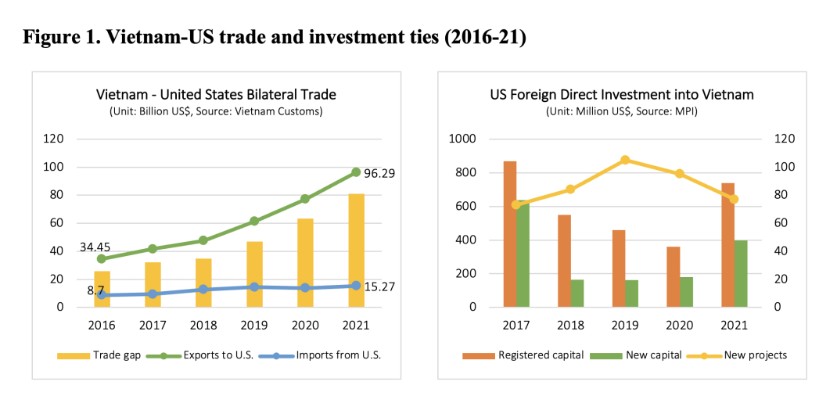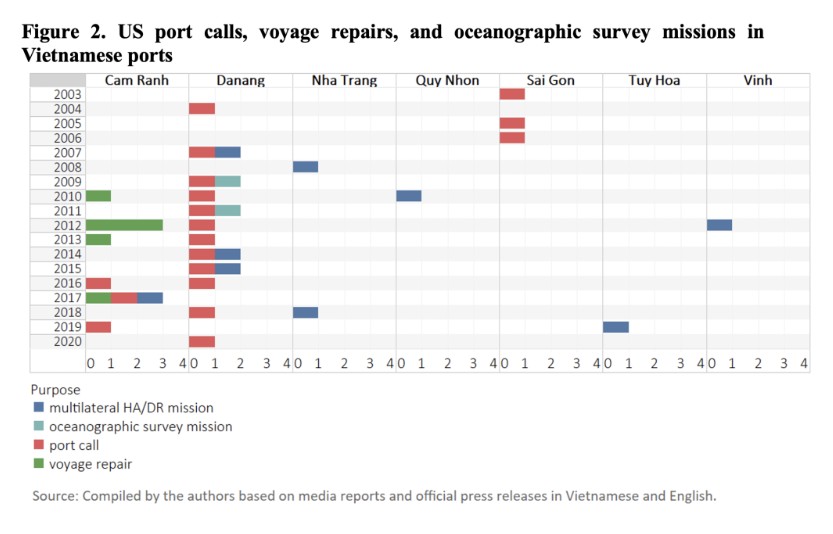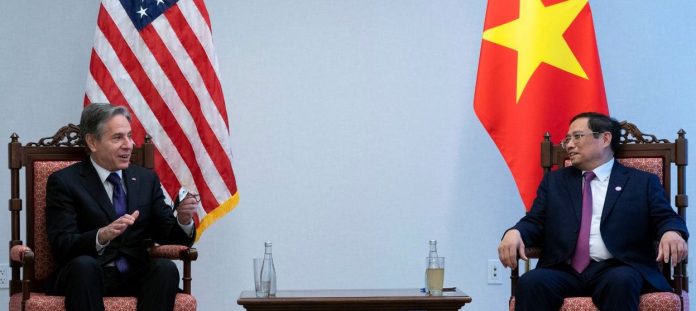Vietnam’s delicate balancing act between major powers suggests that it is unlikely to advance a relationship with one power at the expense of another. Instead, it will try to maintain an independent position and promote ties with all powers, where possible.
INTRODUCTION
When US President Joe Biden released his Indo-Pacific Strategy on 11 February 2022, Vietnam was named one of the leading regional partners of the United States, alongside India, Indonesia, Malaysia, New Zealand, Singapore, Taiwan, and the Pacific Islands. Over the past two years, despite the COVID-19 pandemic, Vietnam has also been visited by various senior US officials, including then-Secretary of State Mike Pompeo in 2020, and Defense Secretary Lloyd Austin and Vice President Kamala Harris in 2021. All signs were pointing toward a positive trajectory for bilateral relations until Russia invaded Ukraine on 24 February. In the two months that followed, Vietnam found itself among a minority of countries that did not support efforts by America and its allies to punish Russia for its invasion. Specifically, Hanoi abstained on two United Nations (UN) General Assembly resolutions that condemned Russia’s invasion and demanded civilian protection and humanitarian access in Ukraine, and voted against a resolution that suspended Russia from the UN Human Rights Council.
Hanoi’s votes on the above resolutions disappointed Western countries. On 8 March, ambassadors of the European Union, Norway, Switzerland and the United Kingdom in Hanoi co-signed a letter urging Vietnam to stand with Ukraine because the Soviet Union, Vietnam’s historical ally, “is long gone and we are in a new era.” However, from Hanoi’s perspective, Russia remains a highly important partner, especially in terms of arms supplies and oil and gas cooperation. Amid the growing pressure to side with the West on the Ukrainian issue, the Vietnamese government has continued business as usual, trying to maintain a balance between the major powers. On 12 March, Vietnam gave the green light for Gazprom International, a subsidiary of the Russian state-owned Gazprom, to go ahead with a US$293 million gas-fired power plant in the central province of Quang Tri. Two weeks later, Foreign Minister Bui Thanh Son welcomed US Department of State Counselor Derek Chollet in Hanoi, and in early May, Vietnam announced that it would provide US$500,000 in humanitarian aid to Ukraine.
The chain of events raises questions about the prospects of Vietnam’s cooperation with partners that impose anti-Russia sanctions, particularly the United States. As Hanoi and Washington will mark ten years of their “comprehensive partnership” in 2023, this provides a timely opportunity to review recent developments in bilateral relations and assess their prospects, especially regarding the potential upgrading of bilateral ties to the “strategic partnership” level.
CEMENTING COMMON GROUND
Expectations for deepening Vietnam-US relations are grounded in a number of factors, but none clearer than the increasingly robust bilateral economic ties (Figure 1). The US is currently Vietnam’s second-largest trading partner after China, while Vietnam is among the top ten trading partners of the US. Between 2016 and 2021, two-way trade turnover more than doubled to US$111.56 billion. In terms of foreign direct investment, America is Vietnam’s 11th biggest investor, with a total of 1,138 projects and accumulative registered capital of US$10.28 billion as of end-2021, up 32.8 per cent and 4.10 per cent from 2017, respectively.

Vietnam’s emergence as a major trading partner of America has been driven partly by shifts in regional supply chains, such as the higher manufacturing costs in China as well as the trade frictions between China and the US. For this reason, although Vietnam and the US are not mutual parties to any comprehensive trade agreements, bilateral trade is likely to maintain its growth momentum. Recently, Washington has announced its Indo-Pacific Economic Framework (IPEF), an attempt to re-engage Asia in the economic domain. Although the IPEF does not offer greater access to the US market, it is envisioned as an inclusive and flexible framework, covering a wide range of issues, from trade facilitation, technology, digital economy, cross-border data flow, clean energy, infrastructure, to high labour and environmental standards.[8] With the US hosting the Asia-Pacific Economic Cooperation (APEC) summit in 2023, Vietnam and other APEC members can expect the US to take further concrete measures to roll out the IPEF, thereby further deepening America’s economic ties with the region.
At a press conference in Hanoi on 20 April 2022, Ambassador Marc Knapper disclosed that the US was preparing to transfer a third coast guard cutter to Vietnam. The announcement was made despite Vietnam’s unwillingness to side with the West on the Ukraine issue, showing the Biden administration’s strong commitment to promoting ties with Vietnam.
Several outstanding trade issues remain between the two countries, including the US Trade Representative’s investigation into Vietnam’s timber trade practices, strict US regulations over the import of Vietnamese catfish, and high anti-dumping tariff on Vietnamese honey. However, these are rather minor issues that are unlikely to significantly constrain bilateral ties going forward.
The two countries are also increasingly aligned on a host of traditional and non-traditional security issues. According to the US Department of State, between 2015 and 2019, the US authorized the permanent export of more than US$32.3 million in defense articles to Vietnam through Direct Commercial Sales. It also registered over US$162 million in active Foreign Military Sales with Vietnam during this period. From 2017 to 2021, Washington provided Hanoi with about US$60 million in security assistance under the Foreign Military Financing (FMF) programme and more than US$20 million under the Southeast Asia Maritime Security Initiative. The FMF spending, which supports capacity building for Vietnam in military education and maritime security/domain awareness, is the third-highest by the US in ASEAN, jumping from merely US$100,000 in 2012 to US$40 million in 2019. At a press conference in Hanoi on 20 April 2022, Ambassador Marc Knapper disclosed that the US was preparing to transfer a third coast guard cutter to Vietnam. The announcement was made despite Vietnam’s unwillingness to side with the West on the Ukraine issue, showing the Biden administration’s strong commitment to promoting ties with Vietnam.
Deepening military-to-military ties are also evidenced by the frequency of US port calls to Vietnam. As shown in Figure 2, between 2009 and 2020, Vietnam received a total of 28 visits by US military vessels, including 13 official port calls, two oceanographic survey missions, and six voyage repairs. There were also nine multilateral humanitarian assistance and disaster relief (HA/DR) preparedness missions within the annual US-led Pacific Partnership framework.

On non-traditional security issues, the United States Agency for International Development (USAID) is implementing different projects in Vietnam that focus on, among other things, infectious diseases control and prevention, environmental security, and overcoming war legacies. Notably, by early May, America had donated nearly 40 million COVID-19 vaccine doses to Vietnam, in addition to US$23.46 million in COVID-19 assistance through USAID. Another potential area for cooperation is energy; the US is committed to helping Vietnam reduce greenhouse gas emissions and develop clean and renewable energy. Vietnam has also approved the USAID Vietnam Low Emission Energy Program II—a five-year US$36-million clean energy project announced by Vice President Kamala Harris during her visit to Vietnam in August 2021.
Currently, the two sides are doing a major dioxin remediation project at Bien Hoa air base, the largest remaining dioxin hot spot in the country. The project, costing US$390 million, was launched in 2019 and would take at least ten years to complete. Although Vietnam and the US have moved beyond past hostilities towards talks of strategic alignment, addressing war legacies remains an important and relevant bilateral goal. The two countries only elevated their relationship to a “comprehensive partnership” in 2013, one year after the US initiated the first major programme for dioxin cleanup in Vietnam. Addressing war legacy issues, including dioxin remediation, unexploded ordnance removal, cooperation on wartime remains recovery, and support for individuals affected by the war, is thus critical to cementing the common ground for a stronger, lasting partnership between the two former enemies.
REALITY CHECK
A recurring question over the past few years is whether and when Vietnam and the US would forge a strategic partnership. The idea was first proposed by then-Secretary of State Hilary Clinton during her visit to Hanoi in 2012 and has since been reiterated by numerous US senior officials, including Vice President Kamala Harris. In the nomination hearing at the US Senate Committee on Foreign Relations on 13 July 2021 for the post of US Ambassador to Vietnam, Marc Knapper said it would be a priority, both for him and America, to develop a strategic relationship with Vietnam during his posting in Hanoi. According to Knapper, this objective can be realized by focusing on three aspects: “strengthening even further our security relationship,” “strengthening our trade and economic ties,” and “deepening our people-to-people ties.” Knapper reaffirmed this aspiration in an interview with a state-run Vietnamese newspaper in February, noting that the upgraded partnership would reflect the genuine nature of bilateral ties going forward. He reiterated this point in April and May, suggesting an upgrade in 2023 as befitting to mark the 10th anniversary of the Vietnam-US comprehensive partnership.
While Vietnam is interested in strengthening ties with the US, China and Russia continue to feature prominently in Hanoi’s strategic calculations. Both countries, seen as America’s strategic rivals, are Vietnam’s “comprehensive strategic partners”—the highest level in Hanoi’s hierarchy of diplomatic relations. As a matter of fact, Vietnam maintains close cooperation with China and Russia in all the three areas that Ambassador Knapper mentioned. For example, while Vietnam is reliant on Russia for arms imports and oil and gas operations in the South China Sea, it is also heavily dependent on China for imports of a wide range of production inputs. As a result, Hanoi has been unwilling to upset its ties with Russia despite western pressures. At the same time, it is also trying to maintain regular high-level exchanges with Beijing despite China’s growing assertiveness in the South China Sea.
The nature of Vietnam’s relationships with China and Russia is not lost on the US. Although that will unlikely discourage Washington from strengthening ties with Hanoi, it prefers a higher diplomatic status, no less important than Vietnam’s three comprehensive strategic partners (China, Russia, and India) or its other 14 strategic partners (Japan, South Korea, Spain, the United Kingdom, Germany, Italy, Indonesia, Thailand, Singapore, France, Malaysia, the Philippines, Australia, and New Zealand).
If anything, the conflict is a useful lesson for the Vietnamese leadership. The ever-increasing pressures on Vietnam to side with either the US or Russia would only reinforce Hanoi’s long-standing belief that not taking sides is a wise decision given its strong desire for strategic autonomy.
To this end, both sides need to understand and even accept certain differences, and on that basis, deepen their cooperation. In a meeting with Ambassador Knapper in Hanoi on 30 March, Prime Minister Pham Minh Chinh mentioned the need for trust-building, particularly through overcoming war legacies. The Vietnamese leader underlined that the comprehensive partnership should be deepened on the basis of “respect for each other’s independence, sovereignty, territorial integrity, political regimes and differences.” The “differences” undoubtedly include the human rights situation in Vietnam that the US has long expressed concerns about. However, even this issue is unlikely to be a major obstacle to bilateral ties going forward. Wishing to focus on economic and strategic cooperation with Hanoi to counter the China challenge, Washington has recently been less critical of Hanoi’s human rights record, making the Vietnamese leadership more comfortable in strengthening ties with Washington.
While the declaration of a strategic partnership between the two countries remains unlikely for now, the steady growth trajectory of bilateral ties since their normalisation in 1995 indicates the making of a reliable partnership. From economic to security cooperation, both sides are seeing eye-to-eye on various issues of strategic importance. In particular, Vietnam supports security-defense cooperative mechanisms suitable to its capabilities and interests, including those in the Indo-Pacific region, as affirmed in Vietnam’s 2019 DefenseWhite Paper. Vietnam and the US also share the same vision for a peaceful and stable regional rules-based order, and the respect for international law and the freedom of navigation and overflight in the South China Sea.
Such positions are unlikely to be affected by the ongoing Russo-Ukrainian conflict. If anything, the conflict is a useful lesson for the Vietnamese leadership. The ever-increasing pressures on Vietnam to side with either the US or Russia would only reinforce Hanoi’s long-standing belief that not taking sides is a wise decision given its strong desire for strategic autonomy. This view has been clarified by Former Deputy Minister of Defense Nguyen Chi Vinh, who stated in a recent interview that “Vietnam is not neutral, Vietnam is independent. Being independent is utterly different from being neutral. We are independent on the basis of ethical principles, international law, and Vietnam’s interests.” Such an emphasis on independence may add further momentum to Vietnam–US ties if Hanoi sees a strengthened partnership with America as essential to its efforts to maintain strategic autonomy and independence, especially in the face of rising pressures from an increasingly assertive China. However, it may also mean that Vietnam will push back against America’s efforts to impose its will on Hanoi, including in the Ukraine issue, if Hanoi considers Washington’s pressures too intrusive and detrimental to its strategic independence.
CONCLUSION
Just as it has taken Vietnam and the United States decades to transform their relationship from foes to friends, it will take time for the two countries to build trust and deepen their current partnership. During this process, bilateral dialogues and engagements in different domains, including trade and investment, cultural, education and people-to-people exchanges, as well as defense and security cooperation activities, should be further strengthened and promoted.
Prime Minister Pham Minh Chinh led a Vietnamese delegation on a working visit to the US on 11-17 May, and joined the Special US-ASEAN Summit in Washington D.C. on 12-13 May. As Chinh’s visit was not a formal bilateral one, there was no bilateral meeting between Chinh and President Joe Biden. However, during a short meeting on the sidelines of the summit, the two leaders touched on the “special” Vietnam-US relationship and reiterated their commitment to bolster bilateral cooperation.[24] President Biden also accepted Chinh’s invitation to visit Vietnam and said he would arrange it at a mutually suitable time. Should the visit happen, ideally next year when the two countries celebrate the 10th anniversary of their comprehensive partnership, it may be the right opportunity for the two sides to upgrade their relationship to the strategic partnership level as a landmark for their deepening ties over the past ten years and pave the way for an even stronger relationship going forward. BY HONG KONG NGUYEN|PHAM MUOI NGUYEN/ FULCRUM




